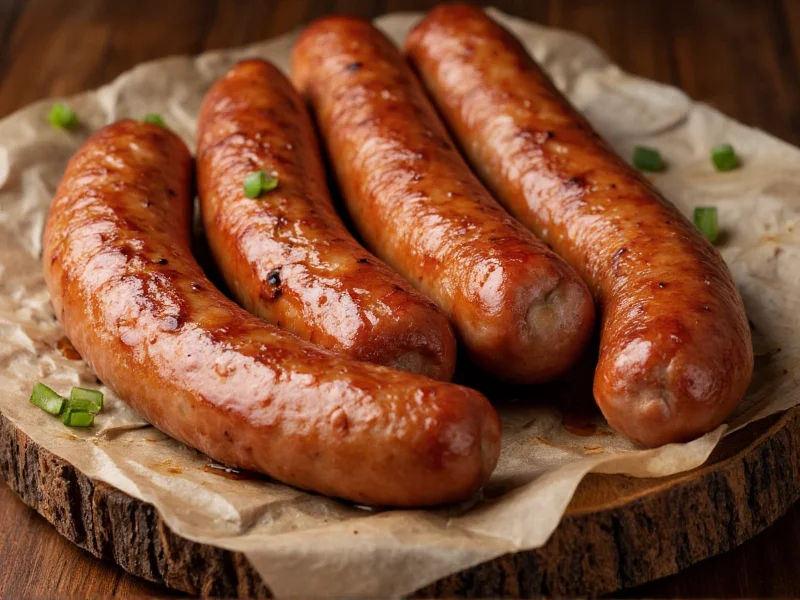When exploring what makes andouille sausage unique among smoked meats, it's essential to understand both its French heritage and Louisiana evolution. This distinctive sausage has become a cornerstone of Southern cooking, prized for its robust flavor profile that withstands long cooking times without losing character. The authentic preparation process involves not just seasoning but a specific double-smoking technique that creates its signature taste.
Historical Journey From France to Louisiana
Andouille's story begins in medieval France, where butchers created this sausage as a way to utilize pork offal. The name derives from the French word "andouille," which itself comes from the Latin "inducere" meaning "to lead in." Traditional French andouille often contained chitterlings (intestines), creating a distinctive texture and flavor.
French settlers brought andouille to Louisiana in the 18th century, where it evolved dramatically. Louisiana's version abandoned the offal in favor of pork shoulder, incorporated local spices like cayenne pepper, and adopted a double-smoking process using local woods. This transformation created what we now recognize as Cajun andouille—spicier, smokier, and more versatile for the region's signature dishes.
Authentic Ingredients and Preparation Methods
True Louisiana-style andouille follows a specific recipe that balances heat, smoke, and meat quality. The essential components include:
- Pork shoulder (70-80% of mixture)
- Fresh garlic (abundant amounts)
- Cayenne pepper (providing distinctive heat)
- Black pepper, paprika, and thyme
- Salt and curing agents
- Natural pork casings
The preparation process separates authentic andouille from ordinary smoked sausages. After grinding the pork coarsely (never finely emulsified), the mixture is heavily seasoned, stuffed into casings, then smoked twice—first at lower temperatures to set the casing, then at higher heat to develop complex smoke flavors. This double-smoking technique creates the characteristic dark reddish-brown exterior and deep, layered flavor profile.
| Sausage Type | Primary Meat | Key Seasonings | Smoking Process | Typical Culinary Use |
|---|---|---|---|---|
| Louisiana Andouille | Pork shoulder | Garlic, cayenne, black pepper | Double-smoked | Flavor base for stews and rice dishes |
| French Andouille | Intestines/offal | Pepper, wine | Lightly smoked | Served as main course, often grilled |
| Chorizo | Pork | Paprika, garlic, vinegar | Rarely smoked | Tapas, fillings, sometimes eaten alone |
| Kielbasa | Pork/beef blend | Marjoram, garlic, pepper | Smoked once | Grilled as main dish or in soups |
Distinguishing Andouille From Similar Sausages
Many home cooks confuse andouille with other smoked sausages, but key differences exist. Understanding what is andouille sausage made of versus alternatives helps in proper recipe execution. While chorizo relies on paprika and vinegar for its distinctive flavor, andouille's identity comes from garlic and cayenne. Kielbasa features marjoram as its signature herb, creating a completely different flavor profile.
The texture difference proves equally important. Authentic andouille maintains a coarse grind that holds up in long-cooked dishes, whereas many commercial sausages use finer grinds that break down. When considering andouille sausage substitutes, remember that the double-smoked quality and coarse texture are as crucial as the spice profile for authentic results in Cajun cooking.
Culinary Applications and Cooking Techniques
Professional chefs recognize that how to cook with andouille sausage properly transforms dishes. Unlike sausages meant for standalone consumption, andouille serves primarily as a flavor foundation. The traditional approach involves slicing andouille into rounds or half-moons and rendering the fat first to create a flavor base for the "holy trinity" (onions, celery, bell peppers).
When making gumbo, many cooks add andouille in two stages—some early for flavor infusion, some later to maintain texture. For jambalaya, the sausage typically gets browned first to release its oils before adding rice. The high fat content and robust seasoning mean andouille can withstand hours of simmering without losing its character, unlike more delicate sausages.
Selecting Quality Andouille and Storage Guidelines
Finding authentic andouille requires attention to labeling and source. When determining where to buy authentic andouille sausage, look for products specifying "Louisiana-style" or "Cajun" and check ingredient lists for natural smoke rather than liquid smoke flavoring. Artisanal producers typically list the smoking woods used (pecan, hickory, or oak).
Proper storage extends andouille's shelf life significantly. Unopened vacuum-sealed packages last 2-3 weeks refrigerated or 2-3 months frozen. Once opened, wrap tightly in butcher paper or vacuum seal for best results. Never store sliced andouille without proper wrapping, as the exposed surfaces dry out quickly.
Nutritional Profile and Dietary Considerations
Understanding the nutritional value of andouille sausage helps incorporate it wisely into meals. A typical 2-ounce serving contains approximately 180-220 calories, 15-18 grams of fat (mostly saturated), 10-12 grams of protein, and 500-700mg of sodium. The high sodium content reflects traditional preservation methods.
While not considered a health food, andouille's strong flavor means small amounts significantly impact dishes, allowing for portion control. For those monitoring sodium intake, rinsing sliced andouille under hot water before cooking removes some surface salt. The substantial protein content makes it a satisfying component in balanced meals when used judiciously as a flavoring agent rather than main protein source.











 浙公网安备
33010002000092号
浙公网安备
33010002000092号 浙B2-20120091-4
浙B2-20120091-4